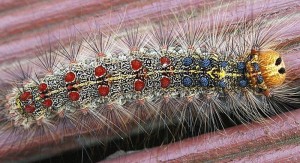
Caterpillars are a favorite insect of children, as they are easy to catch and not likely to bite. Most kids will also know that bright colors indicate the caterpillar will be poisonous if eaten, and spots like eyes are used to scare off predators. It is also understood that caterpillars are an intermediary stage between an emerging from the egg and becoming a full adult.
Fact 1: Many caterpillars have spots that look like eyes, suggesting to the predator that there is a much larger creature they can’t see. Some caterpillars whistle to startle predators, giving them the chance to get away.
Fact 2: Karatoconjunctivitis is a fancy term for dry, irritated eyes. The eye might be red, swollen or painful. This condition can be caused by getting caterpillar hairs in the eye. In fact, these hairs are so lightweight and tiny that they can get sucked into the ventilation of a building and not get filtered out. People can get caterpillar legs in their eyes without ever going outside or seeing a caterpillar.
Fact 3: Most caterpillars are herbivorous, and eat only plants. A few eat other caterpillars and insect larvae. Some Hawaiian caterpillars use their silk glands and spinnerets to restrain live snails to feast on. Â
Fact 4: Hyposmocoma moths are able to feed, breath and mature above or below the water’s surface, or on dry land.
Fact 5: The inchworm is a kind of caterpillar, but all caterpillars walk like the inchworm. The front prolegs support the body weight, the side legs get tense, and the back legs are dragged upward, making the front and back of the body come together. During the next phase of the crawl, the front legs walk away from the back.
Fact 6: Ants usually eat caterpillars, but the lycaenids of Australia have a different approach. Some lycaenids make substances to attract or appease ants. Some have a ‘˜honey gland’ a gland in the middle of the caterpillar body that produces a sugary substance for ants to feed on. Some lycaenids have long tubes structures on their backs that may spray a chemical, but nobody knows for sure.
Fact 7: Waxworm moth caterpillars are raised commercially. They are sold as pet food for insectivorous plants and animals, or as bait for anglers. These caterpillars are a pest to honeybees, destroying wax comb, eating honey, and killing young bees.
Fact 8: Some scientists use caterpillars instead of small mammals for animal testing of microbial and fungal pathogens because of the similarity between insect and vertebrate immune system responses.
Fact 9: Insects have exoskeletons, and most adults that emerge from caterpillars will have one as well. Caterpillars have no bones, inside or out, and have over 1,000 muscles. Caterpillars have skin and shed it, much like snakes.
Fact 10: Frass is the official, scientific term for caterpillar poop. As some caterpillars can gain about 2,500 times their original weight, there is a great deal of frass produced and left behind them as they move on to their next meal.










November 3, 2013 10:52 pm
These are interesting facts about caterpillars. I think children and adults alike like caterpillars or they are their favorite insects. Caterpillars too have interesting and fascinating colors. I honestly had no idea that some caterpillars can be poisonous to eat, however i don’t have any interest on eating them.